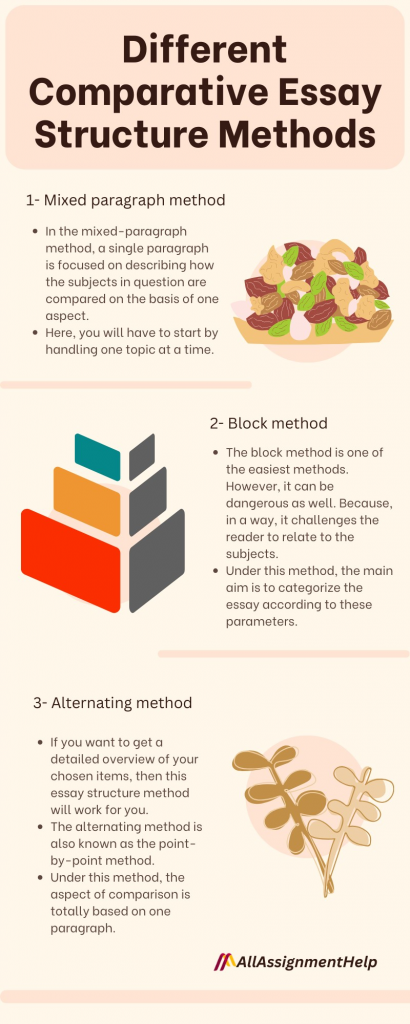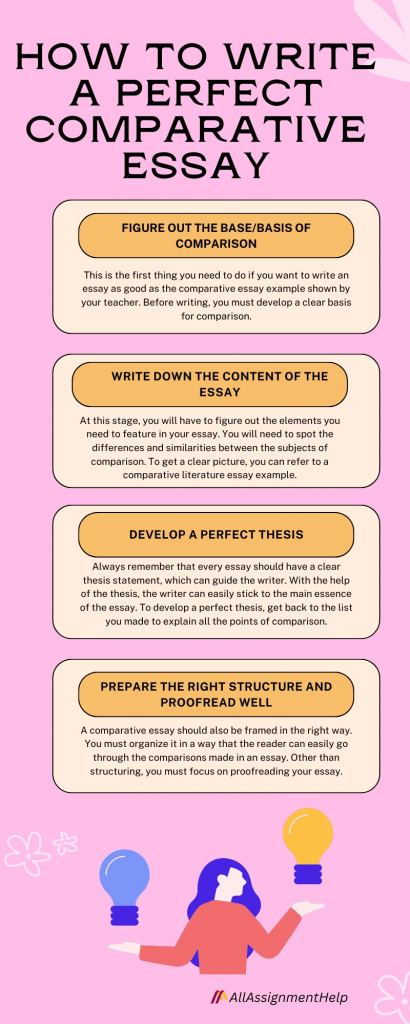Table of Contents
A comparative essay is a type of essay where students must compare two things and compose them all in a readable essay. Here, pupils are required to clearly study two subjects and list their similarities and differences. It is one of the common essay types assigned in schools and colleges. This essay is weighted heavily in terms of grades. So it is important to earn good marks in your comparative essays.
Essay writing is an important part of academics and consists of different crucial steps. To write a perfect essay, one needs to know everything about it. Are you trying to draft a perfect comparative essay? Is it too confusing to write an ideal essay? If you nod your head in “yes”, relax. Go through this blog post from AllAssignmentHelp.com to learn the basics of a comparative essay. Here, you will learn a point-to-point essay structure that will help you craft the best essays.
What is a Comparative Essay?
It is important to know exactly what a comparative essay is before trying to write one. Basically, these essays are composed of several paragraphs that aim at explaining how two things or topics are the same or different from each other. As the name suggests, comparative essays revolve around a comparison of different aspects of the topics in question. There is no limitation on particular topics. They can be written over any subject present on this earth. The only requirement is that the subjects that need to be compared have some relationship.
The word comparative means the one that is brought into focus to judge or measure subjects based on their differences, similarities, or both. Thus, a comparative essay is a type of essay that generally demands the writer make a comparison between two subjects in question that have some relationship in terms of differences and similarities.
If you still do not understand comparative essay writing, you may seek essay assignment help. Seeking professional help will make the concept of such essays more clear, and you will remember them longer.
Also Read: Simple Yet Significant Things to Remember About Transition Words for Compare and Contrast Essay
Different Comparative Essay Structure Methods

Do you know that a good comparative essay depends on the structure of the essay? Yes, to write a perfect essay, you will need to have a proper understanding of all the different structures. The major advantage of essay structure is that it will help readers properly comprehend your written work. There are four different comparative essay structures that organize your essay. The first one is the point-by-point method, the second one is the block method, the third one is the mixed-paragraph method, and the fourth one is the alternating method. Below, in this blog post, we will be further discussing this method in detail.
1- Mixed paragraph method
In the mixed-paragraph method, a single paragraph is focused on describing how the subjects in question are compared on the basis of one aspect. Here, you will have to start by handling one topic at a time. The perks of using the mixed-paragraph method are that the readers can easily identify the comparison factor. Also, it gives equal weight to different subjects in terms of comparison.
2- Block method
The block method is one of the easiest methods. However, it can be dangerous as well. Because, in a way, it challenges the reader to relate to the subjects. Under this method, the main aim is to categorize the essay according to these parameters. For example, in the first paragraph, you will discuss the subjects and items. You need to follow the same method in the second, third, and all the other paragraphs. If you are assigned lengthy essays with complicated and multiple subjects, then this essay is the ideal one to write. However, while writing this essay, you must make sure to write all the subjects in the right order to avoid confusion.
When writing the block method, most students complete the introduction and conclusion parts but get stuck at the main body. Because in the main body, one gets confused about paragraphs, different items, and their different points. To avoid further perplexity, they started to pay for online class help.
3- Alternating method
If you want to get a detailed overview of your chosen items, then this essay structure method will work for you. The alternating method is also known as the point-by-point method. Under this method, the aspect of comparison is totally based on one paragraph. It offers a detailed overview of the items in comparison. This approach makes it easy for the writer to handle two completely different subjects in a question. Also, it generates a highly integrated and perfectly analyzed paper. The point-by-point method is known to provide depth and detailed information. With this method, you can clearly organize items in terms of similarities and differences.
How to Write a Perfect Comparative Essay

We hope that you know what a comparative essay is and the different structures to use to write these essays. Now it’s time to move forward to the important part of this blog post, where we will discuss how to write a perfect comparative essay. However, before actually writing one on your own, it is better to go through some good comparative essays, for example, PDFs or other sources. It happens a lot that beginners write an essay with strong opinions but cannot make it to the final answers. This is something you should surely learn to deal with. Every essay involves questions, and you must present their answers to your readers. It is, therefore, a wise decision to go through an example of a comparative essay. Go through the below-listed tips to master essay writing.
Figure out the base/basis of comparison
This is the first thing you need to do if you want to write an essay as good as the comparative essay example shown by your teacher. Before writing, you must develop a clear basis for comparison. Generally, the question gives the basis for comparison. However, in some cases, the writer has to develop them.
You can understand this through examples:
- Suppose a question asks you to compare Marxism and socialism. This type of question holds a crystal clear objective. With such questions, you will not have to put in extra effort and develop a base of comparison.
- On the other side, if you have to compare any two social issues, In this case, you will have to select two social issues. Here you will have to develop the basis of comparison.
- In order to remember points that you can choose as a basis of comparison for your essay, you can go for wise writing platforms. You can use Diaro, Evernote, and other similar platforms to organize the elements of your essay.
Write down the content of the essay
- At this stage, you will have to figure out the elements you need to feature in your essay. You will need to spot the differences and similarities between the subjects of comparison. To get a clear picture, you can refer to a comparative literature essay example. Develop a list explaining how the subjects in question are similar and different from one another. This is needed to make a perfect plan for the essay.
- Make sure to evaluate it completely. It will help you to keep only the major points of comparison for your final writing. If you have ever come across a good comparative essay example introduction, this is how you can also achieve the same perfection.
- If you are having issues writing down your essay, you may refer to the online expertly-written comparative essay examples. If not, you may hire professionals to complete your comparative essays. There are many assignment helpers available online who can guide you and help you earn top grades.
Develop a perfect thesis
Ever wondered what attracts your attention to a comparative rhetorical analysis essay example? If not, then just focus a little more on their thesis statement. Always remember that every essay should have a clear thesis statement, which can guide the writer. With the help of the thesis, the writer can easily stick to the main essence of the essay. To develop a perfect thesis, get back to the list you made to explain all the points of comparison. Have a quick read and decide whether they are more similar or more different than each other. On the basis of this decision, you can easily develop a thesis statement. If it is tough for you to write a thesis statement, you may refer online and find suitable information. You may also refer to the following blog post, which will provide you with a detailed understanding of the thesis statement. You will also learn how to write a perfect thesis statement for your essay.
Also Read: How to write a Thesis | Thesis definition & examples
Prepare the right structure and proofread well
A comparative essay should also be framed in the right way. You must organize it in a way that the reader can easily go through the comparisons made in an essay. There are three types of comparative essay structures. There are alternative or point-by-point methods, block methods, and mixed-paragraph methods. To know more about these methods and how to use them in your essay, you may refer to the above-given information in this blog post. We have thoroughly discussed the meaning of these essay structures.
Other than structuring, you must focus on proofreading your essay. It is normal for students to make mistakes, but leaving them as they are would be nothing but stupidity. Make sure you proofread your comparative essay before submission to remove all errors. You can use online grammar-checking tools to correct errors in your written work. Grammarly and QuillBot are some of the popular grammar-checking tools used by schools and college students. You may install and correct all your mistakes then and there.
Top Comparative Essay Topics to Write on
Are you tired of searching for a good comparative essay topic for your essay? Are you thinking of getting an online custom essay help to avoid the stress of searching for a suitable topic for your essay? Yes, there is no need to worry anymore. Below, we have listed some of the top comparative essay topics that you may consider writing. You might think that all these topics are easy to write about. But you need to be careful with topic selection and only select topics according to your interests.
- Traditional classroom learning or online learning—which one is better?
- Who are the best: students working while studying or students focusing only on studying?
- Compare the benefits of essay assignments with case study assignments.
- White American vs. Black American
- What similarities do Christians and Muslims have in their religion?
- Individual learning vs. Group learning
- Early morning studies vs. Evening studies: Which are most productive for students?
- Full-time jobs vs. Freelancing
- Master’s degree or job: What should undergraduate students choose?
- Can students living in hostels explore more as compared to students living with their families?
- American health care or Austrian health care—which one is best?
- Apple vs. Android
- Gross national product and gross domestic product: similarities and differences.
- Online tutoring vs. Home tutoring
- Government hospitals or Private hospitals: Where do patients get the best treatment?
Also Read: English Essay: Everything a Novice Needs to Know
Five Important Things to Consider When Writing a Comparative Essay
So far in this blog post, we have discussed everything that will help students in writing their comparative essay. Now that we have reached the end of this write-up, let us give you some important tips. Below, we have listed five tips that will help with effective essay writing.
- Select reliable subjects: Before writing your essay, it is important to select appropriate subjects. You may go for topics that have some connection with each other, or you may go for topics that are completely different from each other. Make sure you choose a topic that has other similarities or differences to explore further.
- Find similarities between topics: Now that you have chosen a reliable subject for your persuasive essay, the next thing is to identify similarities. You need to examine it carefully to clearly understand its meaning, features, scope, and other things. You need to be patient in this step to find a connection between your chosen topics.
- Use some transition phrases: Transition phrases play an important role in essays and ensure a smooth flow of ideas. You must use some phrases, like, however, addition, above all, contrast, in your essay, to provide a clear understanding.
- Supporting evidence should not be missed: If you want to guide your readers through your comparative essay, then do not forget to show some evidence. Supporting evidence could be some examples or relevant proof that will draw your reader’s attention. You may also use reliable sources as evidence.
- Clearly list differences: Establish a basis for comparison and highlight all the differences in your comparative essay. Once you identify the similarities between the subjects, exploring the differences will be easier.
Frequently Asked Questions
| Question 1: What is a comparative essay? Answer 1: The word comparative means the one that is brought into focus to judge or measure subjects based on their differences, similarities, or both. It is a type of essay that discusses the similarities and differences between two subjects. |
| Question 2: What is an outline for a comparison essay? Answer 2: A comparative essay outline consists of three parts, like any other essay. They are the introduction, main body, and conclusion. |
| Question 3: How to start writing a comparative essay? Answer 3: To give the right start to your essay, you must write an attention-grabbing sentence that can attract your readers. Present the main point of your essay in the first paragraph itself. Outline the structure of your essays, include your thesis statement, and set an appropriate tone. |
| Question 4: How many paragraphs are there in a point-by-point comparative essay? Answer 4: A standard point-by-point comparative essay has five paragraphs. The first one is the introduction, which will preview the main content. The second one is the main body, which is further divided into three: body paragraphs 1, body paragraphs 2, and body paragraphs 3. The last one is the conclusion, which will summarize the main point. |
